Unggulan
- Dapatkan link
- X
- Aplikasi Lainnya
Mystery Unveiled: Donut-Shaped Structure Hides Within Earth's Core
- Scientists identified a torus-like area at the upper boundary of the outer core.
- This less dense area aids in agitating the molten metal, thereby producing the magnetic field.
Researchers have discovered an enormous doughnut-like formation hidden deep below the surface of the Earth.
Scientists from the Australian National University utilized seismic waves produced by earthquakes to gaze into the Earth's enigmatic liquid center.
By following the course of these waves through the Earth, the scientists discovered a layer approximately hundreds of kilometers thick where their speed was 2% lower than usual.
This donut-like structure runs parallel to the equator in a ring around the edge of the liquid outer core, and could be responsible for driving our planet's protective magnetic field.
Professor Hrvoje Tkalčić, who led the research, states: "The magnetic field is an essential component required for sustaining life on Earth's surface."


Our planet consists of four primary layers. : the surface crust, the semi-molten mantle, a liquid metal outer core, and a solid metal inner core.
When the movement of tectonic plates in the crust creates earthquakes, these produce vibrations that spread out through all the other layers of the Earth.
Using the worldwide network of seismographic stations, Researchers can observe how the waves propagate and use this information to forecast the circumstances beneath the water's surface.
Scientists usually only look at the big, powerful wavefronts which travel around the world in the first hour or so after an earthquake.
Nevertheless, Professor Tkalčić and his co-author Dr Xiaolong Ma managed to identify this pattern by examining the subtle remnants of waves that persisted for several hours following the original seismic event.
This method revealed that seismic waves travelling near the poles were moving faster than those near the equator.

When they compared their findings with various models of the Earth’s interior, Professor Tkalčić and Dr. Ma discovered that these observations were most accurately described by the existence of an extensive subterranean ‘ring’ or torus-like area shaped like a doughnut.
They forecast that this area exists solely at low latitudes and aligns with the equator close to the upper boundary of the outer core, where the liquid part interfaces with the mantle.
"We aren't certain about the precise thickness of the doughnut, but we deduced that it extends several hundred kilometers below the core-mantle boundary," explains Professor Tkalčić.
Due to the area's significant importance, uncovering these could also have deep impacts on understanding life both on our planet and others.
The Earth's outer core extends about 2,160 miles (3,480 km), which is somewhat bigger than the size of Mars.


Primarily composed of molten nickel and iron, convection currents combined with the Earth's spin cause the fluid metals within this stratum to form elongated vertical whirls extending in a north-south orientation, similar to massive water tornadoes.
The rotating flows within these molten metals function akin to a dynamo, generating the Earth's magnetic field.
As this donut-shaped area has risen to the upper part of the liquid outer core, it implies that it might contain an abundance of lighter elements such as silicon, sulfur, oxygen, hydrogen, or carbon.
Professor Tkalčić states: "Our discoveries are intriguing as this reduced speed within the liquid core suggests a significant presence of lightweight chemical elements in those areas, which would consequently decelerate the seismic waves."


These lightweight components, along with variations in temperature, assist in mixing the liquids within the outer core.
Without that stirring motion to drive the planet's interior dynamo, the Earth's magnetic field might not have formed.
Without the magnetic field, the planet's surface would be exposed to a constant bombardment of charged particles from the sun which can destroy the DNA of living creatures.
This donut-shaped region, therefore, might be a critical piece of the puzzle which explains why life has developed on Earth and what we might look for in habitable planets elsewhere.
Dr Tkalčić concludes: 'Our results could promote more research about the magnetic field on both Earth and other planets.'
Read more- Dapatkan link
- X
- Aplikasi Lainnya
Postingan Populer
National Gallery of Zimbabwe Set to Showcase 80 Photographic Masterpieces
- Dapatkan link
- X
- Aplikasi Lainnya
Nepal: A Golden Land for Content Creators
- Dapatkan link
- X
- Aplikasi Lainnya
Komentar
Posting Komentar